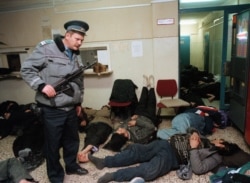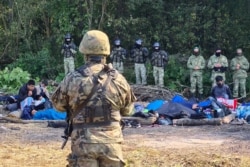On Facebook this week, Hungarian Justice Minister Judit Varga issued a statement about refugees fleeing from the Taliban takeover in Afghanistan.
“We believe it’s not a human right for someone to once get up on one side of the world and decide to go and live in another part of the world from now on,” Varga wrote in the August 23 post.
That is false.
In fact, the right to freedom of movement and choice of residence, and the right to seek and enjoy asylum in any country of the world, are specified in Articles 13 and 14 of the United Nations Universal Declaration of Human Rights (UDHR).
Distinct from treaties, the UDHR is a non-binding document. However, it is a constitutional foundation of the U.N. Charter, as well as part of the International Bill of Human Rights. All U.N. member states, “must accept the obligations of the Charter and be able and willing to carry out those obligations.”
Hungary has been a U.N. member state since 1955 and thus is obligated to follow the Charter and Bill of Human Rights. Violators can be suspended or expelled.
Apart from the U.N. obligations, Hungary is a member of the European Union, which also provides rights for asylum seekers and refugees under The Common European Asylum System (CEAS) and its base treaty, the Geneva Convention.
The CEAS states that the countries of EU must become “an area of freedom, security and justice open to those who, forced by circumstances, legitimately seek protection.” It also states that “Member States are bound by obligations under instruments of international law.”
The Geneva Convention affirms the principle of non-refoulement, meant to ensure that asylum seekers are not sent back to a place of persecution.
As controversy has surged in Europe over refugees from conflicts in Syria, Libya, Iraq and now Afghanistan, Hungary has developed a reputation as an unwelcoming, even hostile place.
To block refugee inflows, the Hungarian government has built wire fences along the country’s borders and granted only 8% of asylum applications, the lowest in Europe, where the average approval rate is 45%.
Hungary also deported thousands of refugees, ignoring the European Court of Justice’s ruling that such deportations violated the EU law.
“So far, Hungarian border guards have sent about 5,000 refugees back to Serbia since December 17, 2020, the day the verdict was announced. Hungary's leader, Viktor Orban, and several members of his government repeatedly have confirmed they intend to continue the practice,” Deutsche Welle reported on August 2.
In 2018, the Hungarian government stopped providing food to the refugees who appealed its denial to grant them asylum and were kept in camps awaiting the court ruling. The authorities prevented people from buying their own food and blocked humanitarian donations, NPR reported at the time.
Those who stayed spent months in isolation in special quarantine camps, amid complaints of hunger from a daily ration of “a piece of bread, a can of sardines and a tiny jar of marmalade,” The New York Times reported.
On August 25, the Hungarian Interior Ministry announced that it evacuated from Afghanistan 240 people (114 adults and 126 children) who cooperated with the Hungarian forces stationed in Afghanistan as part of a NATO mission, and who faced potential retribution from the Taliban.
These refugees have been transported to migrant facilities and are being held in quarantine, the ministry said.
The EU has amended its asylum laws several times in the last decade in response to refugee flows from wars and instability in Africa and the Middle East.
By the U.N.’s estimation, some 5.2 million refugees, mostly from Syria, Iraq, and Afghanistan, had reached European shores by the end of 2016. Thousands died on their “desperate journey,” the U.N. said.
In 2018, some 138,000 people tried to reach Europe by sea, and more than 2,000 drowned.
By 2019, the refugee flow to the EU slowed. Now, the Taliban’s takeover of Afghanistan has renewed concern about a new influx.
“The fall of Afghanistan to Taliban … panicked European politicians who are terrified of another mass movement of Muslim asylum seekers,” The New York Times reported on August 18.
The Times said that in the case of Afghanistan, Europeans may feel a higher moral responsibility compared to other wars because many of its member states were part of the military coalition that invaded the country after the 9/11 terror attacks on the United States.
Since the fall of Afghanistan to the Taliban on August 15 through August 26, President Joe Biden said the U.S. had evacuated more than 100,000 people from Kabul, including American citizens and their families and Afghan allies.
The U.S. has pledged to continue efforts to evacuate Afghans even after the August 31 deadline for pulling troops from the country. On August 26, White House spokeswoman Jen Psaki said, “But our commitment to getting American citizens out, who may not be ready to depart, continues. There is no deadline on — there’s no end of that deadline – end of that timeline, I should say, to getting our Afghan partners out.”
The United Nations Refugee Agency estimated that between January and August 16, some 72,375 Afghans had fled from the conflict seeking asylum in foreign countries.
On August 17, the U.N. Refugee Agency issued a non-return advisory for Afghanistan. “As the situation remains fluid and uncertain, UNHCR continues to call for access to territory to allow civilians fleeing Afghanistan and to ensure respect for the principle of non-refoulement at all times – the prohibition on returning people to situations of danger,” the statement said.
The U.N. Human Rights Office said, “States have a legal and moral responsibility to allow those fleeing Afghanistan to seek safety, and to not forcibly return refugees.”








